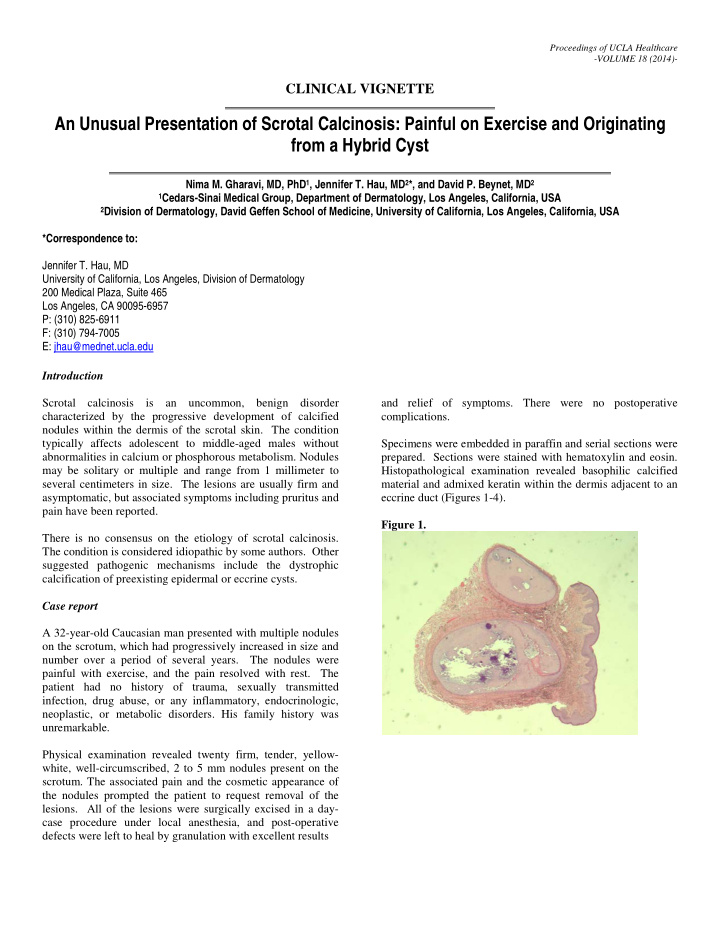



Proceedings of UCLA Healthcare -VOLUME 18 (2014)- CLINICAL VIGNETTE An Unusual Presentation of Scrotal Calcinosis: Painful on Exercise and Originating from a Hybrid Cyst Nima M. Gharavi, MD, PhD 1 , Jennifer T. Hau, MD 2 *, and David P. Beynet, MD 2 1 Cedars-Sinai Medical Group, Department of Dermatology, Los Angeles, California, USA 2 Division of Dermatology, David Geffen School of Medicine, University of California, Los Angeles, California, USA *Correspondence to: Jennifer T. Hau, MD University of California, Los Angeles, Division of Dermatology 200 Medical Plaza, Suite 465 Los Angeles, CA 90095-6957 P: (310) 825-6911 F: (310) 794-7005 E: jhau@mednet.ucla.edu Introduction Scrotal calcinosis is an uncommon, benign disorder and relief of symptoms. There were no postoperative characterized by the progressive development of calcified complications. nodules within the dermis of the scrotal skin. The condition typically affects adolescent to middle-aged males without Specimens were embedded in paraffin and serial sections were abnormalities in calcium or phosphorous metabolism. Nodules prepared. Sections were stained with hematoxylin and eosin. may be solitary or multiple and range from 1 millimeter to Histopathological examination revealed basophilic calcified several centimeters in size. The lesions are usually firm and material and admixed keratin within the dermis adjacent to an asymptomatic, but associated symptoms including pruritus and eccrine duct (Figures 1-4). pain have been reported. Figure 1. There is no consensus on the etiology of scrotal calcinosis. The condition is considered idiopathic by some authors. Other suggested pathogenic mechanisms include the dystrophic calcification of preexisting epidermal or eccrine cysts. Case report A 32-year-old Caucasian man presented with multiple nodules on the scrotum, which had progressively increased in size and number over a period of several years. The nodules were painful with exercise, and the pain resolved with rest. The patient had no history of trauma, sexually transmitted infection, drug abuse, or any inflammatory, endocrinologic, neoplastic, or metabolic disorders. His family history was unremarkable. Physical examination revealed twenty firm, tender, yellow- white, well-circumscribed, 2 to 5 mm nodules present on the scrotum. The associated pain and the cosmetic appearance of the nodules prompted the patient to request removal of the lesions. All of the lesions were surgically excised in a day- case procedure under local anesthesia, and post-operative defects were left to heal by granulation with excellent results
and pelvic pain and Koçak et al 3 described a case of slight Figure 2. pain in the largest of three calcified nodules. The pathogenesis of scrotal calcinosis remains unclear. There is dispute whether the cause of scrotal calcinosis is [1] idiopathic, or secondary to [2] calcific degeneration of epidermoid cysts (pilar or hybrid cysts may also be the source) [3] calcification of eccrine cysts, or [4] dystrophic calcification of the smooth (dartoic) muscle. 4,5 Many cases in the literature are deemed idiopathic, primarily because epithelial cyst linings were not identified on histological analysis. 6-8 Wright et al 6 examined 63 lesions in 9 patients and did not find evidence of keratin in the dermal Figure 3. tissue bordering the calcium deposits, despite staining with the anti-cytokeratin monoclonal antibodies LP34 and PKK1. Swinehart and Golitz proposed that dystrophic calcification of epidermoid cysts led to calcified scrotal nodules after examining 3 cases in which scrotal epidermoid cysts and scrotal calcinosis coexisted. Some of the intact cysts contained calcified keratin and minimal active inflammation, while others demonstrated ruptured walls, granulomatous inflammation, and calcium granules in the adjacent dermis. Based on these findings, the authors suggested that inflammation of an epidermoid cyst leads to calcium deposition in the cyst or, if the cyst wall has ruptured, calcium deposition in the adjacent dermis. Over time, the cyst wall degenerates, leaving only dermal calcium deposits. As a result, epithelial lining is often not identified in samples. 9,10 Figure 4. Song et al 5 supported this theory with a histopathological examination of fifty-one nodules. No significant inflammation was found around cysts with intact lining, while active inflammation was present around calcified keratinous deposits lacking cyst walls. Notably, the cysts with intact lining included not only calcified epidermal cysts, but also a calcified pilar cyst and a calcified hybrid cyst. Therefore, the authors suggested that dystrophic calcification of pilar or hybrid cysts may also lead to scrotal calcinosis. 5 Several investigators have supported the theory of dystrophic calcification of epidermal cysts as the etiology of scrotal calcinosis. 4,5,9-16 Alternatively, Dare and Axelsen suggested that scrotal calcinosis originates from the dystrophic calcification of eccrine duct milia. They described a case in which Discussion histological analysis demonstrated small calcified cysts lined by stratified squamous epithelium. These cysts communicated Scrotal calcinosis was first reported by Lewinski in 1883. 1 with eccrine ducts and stained positively for carcinoembryonic Since then, more than 250 cases have been described in the antigen (CEA) and therefore were identified as eccrine duct literature. Most cases are asymptomatic, but associated milia. 17 Similarly, Ito et al 18 reported cases of scrotal pruritus, pain, infection, a dragging or heavy sensation, skin calcinosis in which calcification was seen in small cysts ulceration, and chalky-white discharge have been reported. determined to be CEA+ eccrine duct milia. In one case of Cases of pain caused by scrotal calcinosis are rare. Tsai et al 2 dystrophic scrotal calcinosis arising from benign eccrine reported a case of scrotal calcinosis causing chronic perineal epithelial cysts, Ito et al demonstrated that calcium deposition may have resulted from discharge of excessive matrical debris
Recommend
More recommend